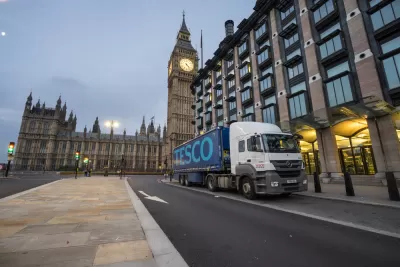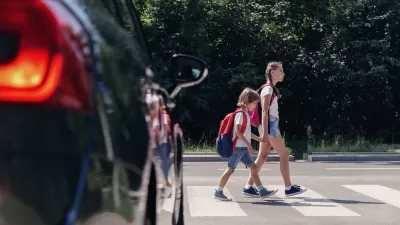The goods movement industry wants a seat at the table.

By Karl Vilacoba
A delivery man pulled and pushed for min-utes on end but couldn’t get his hand truck over the extra high curb. Upon one last try, the frustrated worker’s shipment—a heavy keg of beer—tipped over and rolled into the downtown Washington, D.C., roadway.
At a restaurant across the street, Tom Madrecki watched the episode unfold and considered all of the potential ramifications—safety issues, damaged goods, traffic holdups—which could have been avoided if the curb were a few inches shorter.
American planners spend countless hours mulling how to solve the last-mile question in their cities. But Madrecki’s employer, the world’s largest shipping company, the United Parcel Service (UPS), is concerned above all with the last 50 feet.
“It’s that last 50 feet of the trip where so much can happen, and a lot of things taking place on the city’s side are impacting UPS,” Madrecki, a spokesman for the company, said.
The goal of complete streets policies and improvements is to make streets accessible for all users. In practice, it usually means making car-oriented roads safer for bicyclists and pedestrians. However, complete streets design changes — such as narrower roads and bike lanes—are often the exact opposite of what makes life easier for a truck driver.
Opposing market forces are making the conflicts more pronounced. On one hand, real estate trends nationwide have swung in favor of living spaces in urban cores or downtown areas where residents can walk to stores, restaurants and nightlife. At the same time, the e-commerce revolution has put retail spaces out of business and brought about a surge in deliveries to dense neighborhoods that was never planned for.
How big? According to Alison Conway, a freight policy and logistics expert with the Department of Civil Engineering at the City College of New York, recent research in Fort Lee, New Jersey, found that each residence received about 1.5 packages per week. That means the town’s high-rise apartment buildings overlooking the Manhattan skyline can generate in the neighborhood of 2,000-3,000 deliveries per week.
That said, goods movement experts from around the country say that freight and complete streets are more than compatible. They offered the following food for thought for planners and policymakers as they craft complete streets policies and gear up for road improvement projects.
FULL STORY: Factoring Freight into Complete Streets Plans

Alabama: Trump Terminates Settlements for Black Communities Harmed By Raw Sewage
Trump deemed the landmark civil rights agreement “illegal DEI and environmental justice policy.”

Planetizen Federal Action Tracker
A weekly monitor of how Trump’s orders and actions are impacting planners and planning in America.

Why Should We Subsidize Public Transportation?
Many public transit agencies face financial stress due to rising costs, declining fare revenue, and declining subsidies. Transit advocates must provide a strong business case for increasing public transit funding.

Understanding Road Diets
An explainer from Momentum highlights the advantages of reducing vehicle lanes in favor of more bike, transit, and pedestrian infrastructure.

New California Law Regulates Warehouse Pollution
A new law tightens building and emissions regulations for large distribution warehouses to mitigate air pollution and traffic in surrounding communities.

Phoenix Announces Opening Date for Light Rail Extension
The South Central extension will connect South Phoenix to downtown and other major hubs starting on June 7.
Urban Design for Planners 1: Software Tools
This six-course series explores essential urban design concepts using open source software and equips planners with the tools they need to participate fully in the urban design process.
Planning for Universal Design
Learn the tools for implementing Universal Design in planning regulations.
Caltrans
Smith Gee Studio
Institute for Housing and Urban Development Studies (IHS)
City of Grandview
Harvard GSD Executive Education
Toledo-Lucas County Plan Commissions
Salt Lake City
NYU Wagner Graduate School of Public Service





























